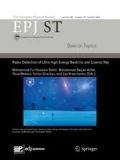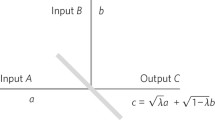Abstract
We discuss the optimum communication capacity of bosonic information carriers propagating through a tunnel junction. Based on the multi-contour Keldysh Green function, we evaluate the information generating function, or the Rényi entanglement entropy, of the reduced density matrix subjected to the constraint of local heat quantity in the steady state. The Rényi entanglement entropy of order zero is the partition function, which exponentially depends on the optimum capacity. For the perfect transmission, the self-information and the local heat quantity, i.e., the energy of signals, are perfectly linearly correlated. The water-filling theorem is recovered in the wave-like regime.



Similar content being viewed by others
References
C.E. Shannon, Bell Syst. Tech. J. 27(379–423), 623–656 (1948)
T.M. Cover, J.A. Thomas, Elements of Information Theory, 2nd edn. (Wiley-Interscience, New York, 2006)
R. Landauer, Science 272, 1914 (1996)
S. Lloyd, Nature 406, 1047 (2000)
D.S. Lebedev, L.B. Levitin, Dokl. Akad. Nauk SSSR 149, 1299 (1963) [Sov. Phys. Dokl. 8, 377 (1963)]
D.S. Lebedev, L.B. Levitin, Inf. Control 9, 1 (1966)
J.B. Pendry, J. Phys. A Math. Gen. 16, 2161 (1983)
C.M. Caves, P.D. Drummond, Rev. Mod. Phys. 66, 481 (1994)
M.P. Blencowe, V. Vitelli, Phys. Rev. A 62, 052104 (2000)
J.D. Bekenstein, A.E. Mayo, Gen. Relativ. Gravit. 33, 2095 (2001)
Y. Utsumi, Phys. Rev. B 96, 085304 (2019)
S.W. Golomb, IEEE Trans. Inf. Theory IT–12, 75 (1966)
S. Guiasu, C. Reischer, Inf. Sci. 35, 235 (1985)
U. Sivan, Y. Imry, Phys. Rev. B 33, 551 (1986)
M.A. Nielsen, I.L. Chuang, Quantum Computation and Quantum Information (Cambridge University Press, New York, 2000)
G.E. Andrews, The Theory of Partitions (Encyclopedia of Mathematics and its Applications) (Cambridge University Press, Cambridge, 1984)
M.P. Blencowe, N.C. Koshnick, J. Math. Phys. 42, 5713 (2001)
H. Touchette, Phys. Rep. 478, 1 (2009)
R.M. Fano, Transmission of Information: A Statistical Theory of Communications (The MIT Press, Cambridge, 1961)
A. Rényi, Proceedings of the Fourth Berkeley Symposium on Mathematics, Statistics, and Probability (University of California Press, Berkeley, 1960), p. 547
M. Campisi, P. Hänggi, M. Talkner, Rev. Mod. Phys. 83, 771 (2011)
Yu.V. Nazarov, Phys. Rev. B 84, 205437 (2011)
M.H. Ansari, Yu.V. Nazarov, Phys. Rev. B 91, 174303 (2015)
M.H. Ansari, Yu.V. Nazarov, Phys. Rev. B 91, 174307 (2015)
M.H. Ansari, Yu.V. Nazarov, J. Exp. Theor. Phys. 122, 389 (2016)
Y. Utsumi, Phys. Rev. B 92, 165312 (2015)
M.H. Ansari, Phys. Rev. B 95, 174302 (2017)
Y. Utsumi, Phys. Rev. B 96, 085304 (2017)
Y. Utsumi, Eur. Phys. J. Spec. Top. (2019). https://doi.org/10.1140/epjst/e2018-800043-4
A. Petrescu, H.F. Song, S. Rachel, Z. Ristivojevic, C. Flindt, N. Laflorencie, I. Klich, N. Regnault, K. Le Hur, J. Stat. Mech.2014, P10005 (2014). https://doi.org/10.1088/1742-5468/2014/10/P10005
P. Calabrese, A. Lefevre, Phys. Rev. A 78, 032329 (2008)
Y. Utsumi, D.S. Golubev, Gerd Schön, Phys. Rev. Lett. 96, 086803 (2006)
K. Saito, Y. Utsumi, Phys. Rev. B 78, 115429 (2008)
Y. Utsumi, K. Saito, Phys. Rev. B 79, 235311 (2009)
M. Esposito, U. Harbola, S. Mukamel, Rev. Mod. Phys. 81, 1665 (2009)
T.-H. Park, M. Galperin, Phys. Rev. B 84, 205450 (2011)
A. Kamenev, Field Theory of Nonequilibrium Systems (Cambridge University Press, Cambridge, 2011)
Y. Utsumi, O. Entin-Wohlman, A. Ueda, A. Aharony, Phys. Rev. B 87, 115407 (2013)
H. Casini, M. Huerta, J. Phys. A 42, 504007 (2009)
Acknowledgements
This work was supported by JSPS KAKENHI 17K05575, 18KK0385, and 20H01827. Y. U. performed calculations and wrote the manuscript.
Author information
Authors and Affiliations
Corresponding author
Appendix A: Multi-contour Keldysh technique
Appendix A: Multi-contour Keldysh technique
A component of \(2 M \times 2 M\) multi-contour Keldysh Green function matrix \(\mathbf{g}_{A}\) connecting \(C_{m^\prime ,s^\prime }\) and \(C_{m,s}\) is [22,23,24,25,26,27,28,29],
The \(2 M \times 2M\) matrix \(\mathbf{g}_{A}\) is a block circulant as,
where \(n_{A , m}(\omega ) = \mathrm{e}^{-\beta _{A} \omega m} /\left( 1- \mathrm{e}^{ -\beta _A \omega (M-i \chi )} \right) \). The block circulant matrix is block-diagonalized by the discrete Fourier transform, \(\sum _{m=0}^{M-1} \mathbf{A}_{m} \mathrm{e}^{i 2 \pi \ell m/M } = \mathbf{g}_{A}^{\lambda _\ell }\), where \(\lambda _\ell = (2 \pi \ell + \omega \chi )/M\) and
A multi-contour Keldysh Green function of subsystem B is nonzero when \({\hat{a}}_{B,m}\) and \({\hat{a}}_{B,m'}^\dagger \) are on the same (standard) Keldysh contour \(m=m'\). It is given as,
where \(\mathbf{1}_M\) is the \(M \times M\) identity matrix.
The Keldysh partition function (21) can be calculated by exploiting standard Keldysh techniques, see e.g. [32,33,34,35,36,37,38]. In the limit of long measurement time, the leading contribution is proportional to \(\tau \) as,
where \(\ln {{\mathcal {Z}}}_\tau \) is the current cummulant generating function of full counting statistics in the single-time measurement protocol,
We rewrite the summation over \(\ell \) as the contour integral (Fig. 3a) as [39],
If \(i \chi <0\) and \(\beta _B<\beta _A\), branch points of the integrand \(\ln {{\mathcal {Z}}}_\tau \), \(u_+(\omega )=n_A^-(\omega )/(n_A^+(\omega )\mathrm{e}^{i \omega \chi /M})\) and \(u_-(\omega )={\tilde{n}}_A^-(\omega )/({\tilde{n}}_A^+(\omega )\mathrm{e}^{i \omega \chi /M})\) are on the real axis and satisfy \(1<u_-(\omega )<u_+(\omega )\). By changing the contour as Fig. 3b and by utilizing \(\sum _{\ell =0}^{M-1} (u-\mathrm{e}^{i 2 \pi \ell /M})^{-1} = \partial _u \ln (u^M-1)\), we obtain Eq. (22).
Rights and permissions
About this article
Cite this article
Utsumi, Y. Fluctuation of information content and the optimum capacity for bosonic transport. Eur. Phys. J. Spec. Top. 230, 1059–1066 (2021). https://doi.org/10.1140/epjs/s11734-021-00074-4
Received:
Accepted:
Published:
Issue Date:
DOI: https://doi.org/10.1140/epjs/s11734-021-00074-4



